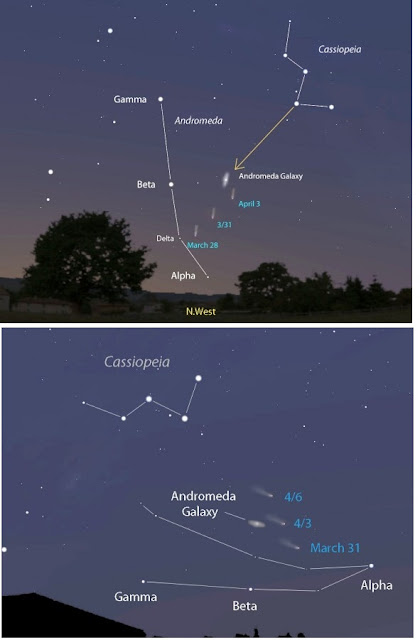
Bob King provides tips in
Universe Today article for best viewing of
Comet PANNSTARRS in the next week.
"Get ready for an comet encounter of the extragalactic kind. In less than a week, Comet PANSTARRS will slide by the Andromeda Galaxy, the brightest galaxy visible in northern hemisphere skies. On and around that date, you’ll be able to see them both glowing softly together in late evening and early morning twilight," writes King. The article supplies specific guidance, directing reader to an area of morning or evening sky to spot comet:
"It won’t be long before the comet becomes circumpolar and remains visible all night long. The term refers to celestial objects that circle around the pole star without setting. The Big Dipper is the most familiar circumpolar constellation for much of the U.S. and Canada. On its journey to all-night visibility, PANSTARRS started pulling a double-shift this week. You can now see it both at dusk and at dawn. Although a bright moon will compromise the dawn view for a few days, you can watch for the comet low in the northeastern sky starting about hour and 15 minutes before sunrise. For the moment, it’s about the same altitude above the horizon during both morning and evening hours. Evening is still preferred only because the bright moon has finally departed the sky during the hour or so the comet is visible."
You can hardly go wrong, by simply, utilizing illustrations (top and bottom pictures) to help spot PANNSTARRS - hats off to Bob King!
 Bob King provides tips in Universe Today article for best viewing of Comet PANNSTARRS in the next week. "Get ready for an comet encounter of the extragalactic kind. In less than a week, Comet PANSTARRS will slide by the Andromeda Galaxy, the brightest galaxy visible in northern hemisphere skies. On and around that date, you’ll be able to see them both glowing softly together in late evening and early morning twilight," writes King. The article supplies specific guidance, directing reader to an area of morning or evening sky to spot comet:
Bob King provides tips in Universe Today article for best viewing of Comet PANNSTARRS in the next week. "Get ready for an comet encounter of the extragalactic kind. In less than a week, Comet PANSTARRS will slide by the Andromeda Galaxy, the brightest galaxy visible in northern hemisphere skies. On and around that date, you’ll be able to see them both glowing softly together in late evening and early morning twilight," writes King. The article supplies specific guidance, directing reader to an area of morning or evening sky to spot comet:
No comments:
Post a Comment